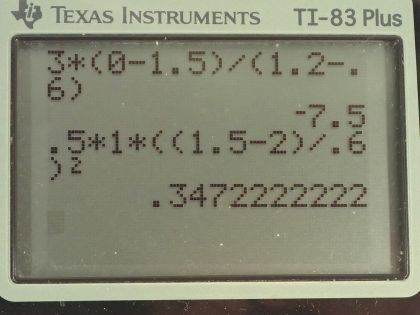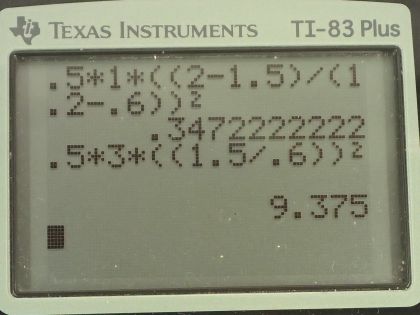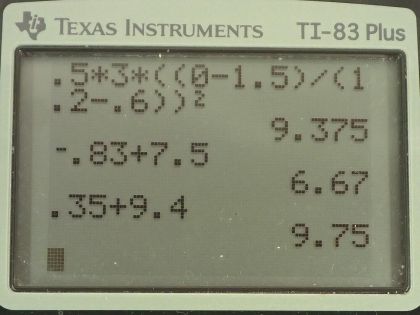Question
For the below graph, determine the initial and final momentum for both objects, assuming mass A is 1.0 kg and mass B is 3.0 kg. Also, determine the initial and final kinetic energies for both objects. Based on your results, explain whether momentum is conserved in this collision, and state whether the collision is elastic or inelastic.
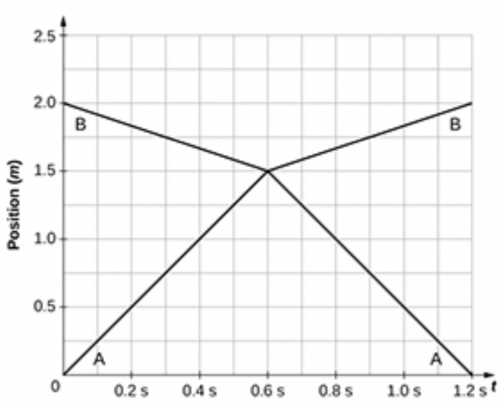
Final Answer
Yes, momentum is conserved. Since kinetic energy is also conserved, this collision is elastic.
Solution video
OpenStax College Physics for AP® Courses, Chapter 8, Problem 38 (Test Prep for AP® Courses)
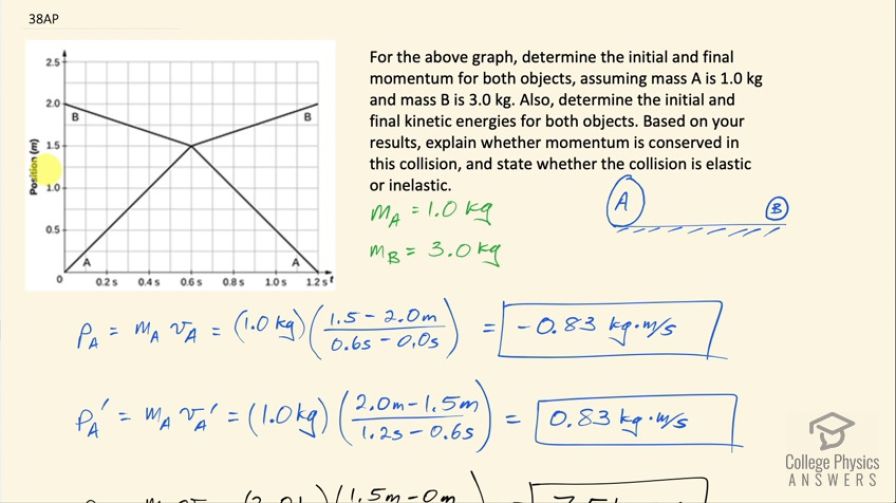
vote with a rating of
votes with an average rating of
.
Calculator Screenshots
Video Transcript
This is College Physics Answers with Shaun Dychko. This graph is showing us the position of two masses that are moving along a straight line so mass B begins at a position 2.0 meters from the origin here—this is the origin and here is x equals 2.0 meters— and this object B is moving to the left and it reaches a position 1.5 meters at 0.6 seconds and so it's moving to here say this looks like it will be about 1.5... 1.5 meters and here is 1.0 meter and when object B is here, at the same time object A will be there hitting it and then they will bounce apart and object A will then move to the left and object B will move to the right after that collision. So this is showing us the position for each of these masses along this straight line at different times. Now our job is to figure out what the initial and final momenta are for the two objects and then also the initial and final kinetic energies and then determine whether momentum is conservered in the collision and whether or not kinetic energy is conserved because if kinetic energy is conserved, we can say the collision is elastic. So extracting data from our question into variables here as a first step writing down the things that we know— we know mass A is 1.0 kilogram and mass B is 3.0 kilograms— and let us get started with the momentum of mass A: it will be the mass of object A times its velocity. So that's 1.0 kilogram times the change in position divided by the change in time— that's going to be its velocity. So it starts... well, its final position—this is x f minus x i over t f minus t i— so final x position is 1.5 meters here reading across the vertical axis minus the initial 2.0 meters that it started at divided by 0.6 seconds here minus 0 seconds to begin with and that is negative 0.83 kilogram meters per second. The momentum of mass A after the collision is its mass times its velocity after collision so that's 1.0 kilogram times the final x position, which is 2.0 meters minus the initial x position for this period of time, which is 1.5 meters divided by 1.2 seconds divided by... or minus 0.6 seconds and that is 0.83 kilogram meters per second positive. The momentum for object B will be its mass of 3.0 kilograms times its change in position divided by change in time so before the collision, we have a final position of 1.5 meters minus an initial position of 0 meters divided by 0.6 seconds of the final time minus the 0 seconds initial time and that's 7.5 kilogram meters per second. After the collision, we have 3.0 kilograms times a final position of 0 meters— it's back to the origin— minus the initial position of 1.5 meters at the beginning of this period of time after the collision and then divide that by 1.2 seconds minus 0.6 seconds and that's negative 7.5 kilogram meters per second. The kinetic energy for mass A before the collision is one-half times its mass times its initial velocity squared. So that's one-half times 1.0 kilogram times the same change in position over time as we had in this momentum calculation so that's 1.5 meters—final position—minus 2.0 meters—initial position— divided by 0.6 seconds and we square that and we get 0.35 joules. The final kinetic energy for mass A is one-half times 1.0 kilogram times 2.0 meters minus 1.5 meters over 1.2 seconds minus 0.6 seconds, which is positive 0.35 joules as well. The kinetic energy for object B is one-half times 3.0 kilograms times its change in position over time before the collision and we square that and that's 9.4 joules and the kinetic energy for mass B after collision is a half times 3.0 kilograms times negative 1.5 meters divided by 1.2 minus 0.6 seconds square that and we get 9.4 joules again. Is momentum conserved? Well if the total momentum before the collision equals the total momentum after collision then we can say yes, momentum is conserved. So the momentum of object A before collision is negative 0.83 kilogram meters per second and momentum for object B before collision is 7.5 and that adds up to 6.67 kilogram meters per second and after the collision, we have positive 0.83 kilogram meters per second for the momentum of object A whereas object B is momentum of negative 7.5 and that also adds to 6.67 and because these are the same, we can say yes, momentum is conserved. Is the collision elastic? That's another way of asking is the total initial kinetic energy equal the total final kinetic energy? So we have the kinetic energy of object A plus object B before the collision 0.35 joules plus 9.4 joules, which is 9.75 joules and whereas after the collision, we have 0.35 plus 9.4 again and so we can say yes, kinetic energy is conserved because in both cases, the total is 9.75 joules and the collision is elastic.

